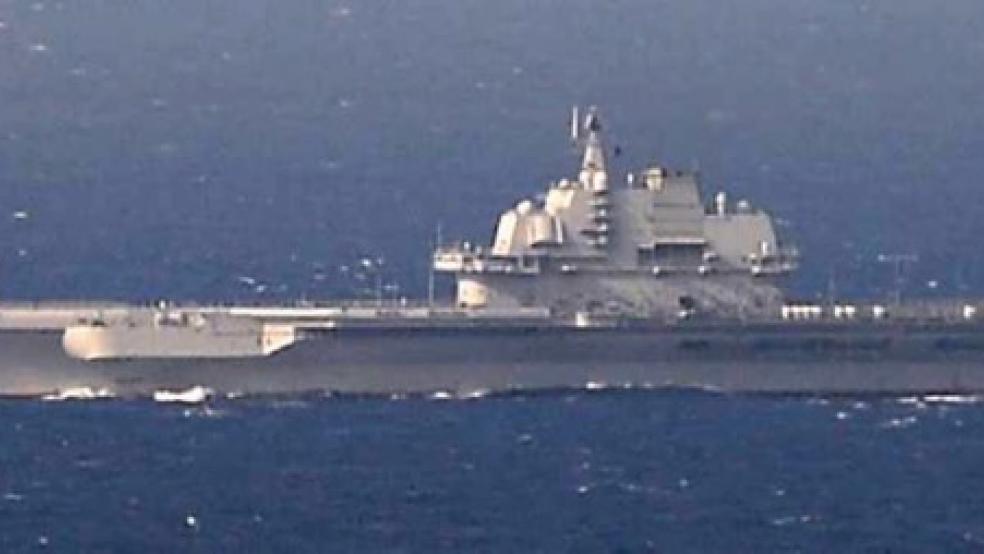China sent president-elect Donald Trump a not-so-subtle signal on Monday when its first aircraft carrier, accompanied by five warships, sailed in disputed waters of the South China Sea.
The implicit message from Beijing was: We are not cowed by your tough talk.
Related: As Trump Gets Tough With China, Facebook Plays Their Game
The Liaoning, a 999-foot retrofitted aircraft carrier, sailed past islands controlled by Taiwan, which has become a flashpoint in emerging relations between China and Trump since he took a congratulatory post-election call from Taiwanese President Tsai Ing-wen.
That was the first direct contact between an American president and the leader of Taiwan since 1979, and it called into question the future of the “One China” policy that has been a bedrock of Washington-Beijing relations for decades.
More recently, Trump took China to task for seizing a U.S. submersible drone in international waters near the Philippines on December 15:
China steals United States Navy research drone in international waters - rips it out of water and takes it to China in unprecedented act.
— Donald J. Trump (@realDonaldTrump) December 17, 2016
After objections from the Obama Administration, the ocean-monitoring drone was returned.
Taking the drone was also seen a message to Trump. Patrick M. Cronin, senior director of the Asia-Pacific Security Program at the Center for a New American Security, a Washington think tank, told The New York Times:
“I see the snatched drone as a calculated act of coercive diplomacy approved at the top. I believe Beijing accelerated plans to create an early test for the new administration because Trump publicly called into question the One China policy and because China judged it safer to provoke Obama than an unpredictable Trump.”
Related: What a Trade War With China Could Do to the Economy
The New Yorker Online made the case last week that Trump has taken a page from his best-selling The Art of the Deal and is being provocative with China to gain leverage. It cited the following tactic (whether conceived by Trump or his co-writer): “My style of deal-making is quite simple and straightforward. I aim very high, and then I just keep pushing and pushing and pushing to get what I’m after. Sometimes I settle for less than I sought, but in most cases, I still end up with what I want.”
Wrote Jiayang Fan: “…Those words provide a notion of Trump’s self-image and, in conjunction with his Twitter tirades, a rough contour of his China strategy.”
China may also have taken a less obvious shot across Trump’s bow on Dec. 8 when it placed restrictions on the amount of money gamblers in Macau can withdraw from the ATMs of China UnionPay Co.
What has that got to do with Beijing’s anger at the president-elect? It’s complicated.
There are limits on how much cash mainland Chinese gamblers are allowed to take across the border to the autonomous territory of Macau, which has been called the “Las Vegas of Asia.” So, about 50 percent of Chinese visitors use UnionPay ATM cards to withdraw more gambling money, according to Bloomberg.
Related: Making Friends with Russia May Be Harder than Trump Seems to Think
The new restrictions sent shares of U.S. gambling stocks tumbling, including Wynn Macau, which opened the $4.2 billion Wynn Palace last summer and Las Vegas Sands Corp. (LVSC), which opened the $2.9 billion Parisian Macau in September. LVSC shares dropped by 13 percent.
Las Vegas Sands is controlled by billionaire and GOP mega-donor Sheldon Adelson, who along with his wife, Miriam, just happened to be Donald Trump’s biggest campaign contributors, giving more than $20 million toward his election.
Beijing almost immediately softened the restrictions, putting a cap on per-transaction withdrawals and not imposing a daily limit. But the writing on the casino wall was clear: Retaliation can take many forms.





